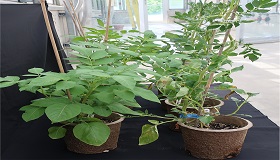Set up an interview
Media Relations
Agriculture and Agri-Food Canada
1-866-345-7972
aafc.mediarelations-relationsmedias.aac@agr.gc.ca
Originating in the cool Andes region of South America, potatoes grow best when the daytime temperature is around 20°C. That makes Canada, with its temperate climate, a great place to grow spuds.
But with global temperatures on the rise, potato crops are experiencing heat stress that is affecting yields and quality across the country.
In a recently published study of heat stress, Dr. Xiu-Qing Li’s team at the Fredericton Research and Development Centre of Agriculture and Agri-Food Canada (AAFC) raised the temperature on 55 of Canada’s most popular potato varieties and found that some varieties can take the heat better than others.
That heat hardiness is offering researchers clues that could lead to the development of potato varieties that thrive in higher temperatures, says study lead Dr. Li.
During the stress study, the potatoes were grown in a greenhouse with a daytime temperature of 35°C and a nighttime temperature of 28°C. A second set of the potatoes were grown under ideal growing conditions, 22°C during the day and 18°C at night.
Researchers compared the two sets of potato plants, their estimated chlorophyll content, plant height, and the mass of the largest tuber produced. They found that, under heat-stress conditions, potato cultivars that tended to show less reduction in tuber mass had greater amounts of leaf chlorophyll content and the plants were taller.
Dr. Li says this study clearly shows that different potato varieties have varying degrees of tolerance to heat stress.
“We now know that there is a correlation among changes of plant height, the chlorophyll content in the leaves, and the tuber mass under heat stress. These findings on genetic variation of potato varieties will serve as a basis to identify the genes responsible for heat tolerance, improve existing varieties, and breed new heat tolerant varieties.”
Dr. Xiu-Qing Li, Research Scientist, Agriculture and Agri-Food Canada
Compared to the control group, all the potato varieties grown under higher temperatures had smaller tubers and leaves.
Russet Burbank, one of the most popular varieties in the fresh and processing markets, produced only one single, very small tuber under temperature-stressed conditions while the varieties that showed the most tolerance were Eramosa and Chieftain.
Dr. Li says that heat stress signals the plants to switch the photosynthetic product from tuber development to aboveground growth, and his team is looking at the genetic variations of potato varieties under heat stress to find a way to switch the signal back to growing tubers.
AAFC potato breeder Dr. David De Koeyer says climate change and its impact on potato performance is something his team will continue to monitor at growing sites across the country.
He will be using Dr. Li’s greenhouse study to see how the results compare to responses in the field under variable weather conditions. Both approaches, he says, will provide scientists with more information to help identify the genes associated with heat tolerance.
Photo gallery

